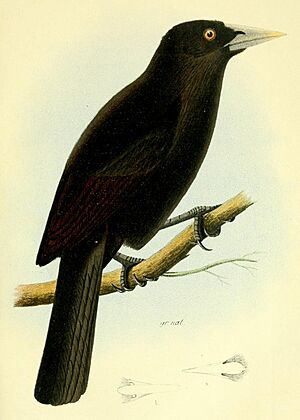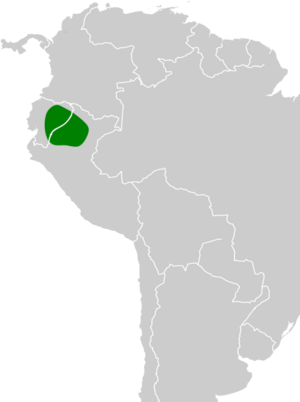Ecuadorian cacique facts for kids
Quick facts for kids Ecuadorian cacique |
|
|---|---|
 |
|
| Conservation status | |
| Scientific classification | |
| Genus: |
Cacicus
|
| Species: |
sclateri
|
 |
|
| Range of Cacicus sclateri | |
The Ecuadorian cacique (Cacicus sclateri) is a type of bird. It belongs to the Icteridae family, which includes many colorful birds like orioles and blackbirds. You can find this bird in Colombia, Ecuador, and Peru.
It lives in warm, wet forests, usually in low-lying areas. This bird is quite common and lives across a wide area. Because of this, the IUCN says it is a "species of least concern". This means it is not currently in danger of disappearing.
Contents
What Does the Ecuadorian Cacique Look Like?
The male Ecuadorian cacique grows to about 23 centimeters (9 inches) long. The female is a bit smaller. Both male and female birds are completely black.
Their beak is whitish, long, and pointed. Adult birds have bright blue eyes, while young birds have brown eyes.
How to Tell Them Apart
It can be tricky to tell the Ecuadorian cacique apart from similar birds. The solitary cacique looks a lot like it. However, the solitary cacique is larger. It also has darker eyes and spends more time closer to the ground.
Another similar bird is the red-rumped cacique. When the red-rumped cacique flies, you can see a bright red patch on its bottom. The Ecuadorian cacique does not have this red patch.
Their Calls
These birds are quite noisy! They make many different sounds. You might hear a repeated "péach-yo" or "péach-yo-yo." They often make these sounds while perched with their tail raised. Other calls include a "k-cheeyow?" and a "kweeyh-kweeyh-kweeyh-kweeyh-wonhh?".
Where Do Ecuadorian Caciques Live?
The Ecuadorian cacique is native to South America. It lives in the southern parts of Colombia, eastern Ecuador, and northeastern Peru.
They prefer to live in damp woodlands. You can also find them at the edges of forests near rivers. They usually live in areas up to 400 meters (1,300 feet) above sea level.
What Do Ecuadorian Caciques Eat?
The Ecuadorian cacique spends most of its time in trees. It usually looks for food alone. Sometimes, you might see a pair or a small family group moving through the treetops.
They often visit trees that have flowers and fruits. They have even been seen poking into the stems of Cecropia trees. Their main diet includes insects like ants, beetles, and caterpillars. They also enjoy eating fruit and might even drink nectar from flowers.
Is the Ecuadorian Cacique in Danger?
The Ecuadorian cacique lives across a very large area. Its habitat covers about 294,000 square kilometers (113,500 square miles).
The tropical forests where it lives are slowly being damaged. This means there is less suitable habitat for the birds. However, the Ecuadorian cacique is still quite common. Any decrease in its total population is likely to be slow. Because of this, the International Union for Conservation of Nature has listed its conservation status as "least concern". This means they are not worried about it becoming endangered soon.


